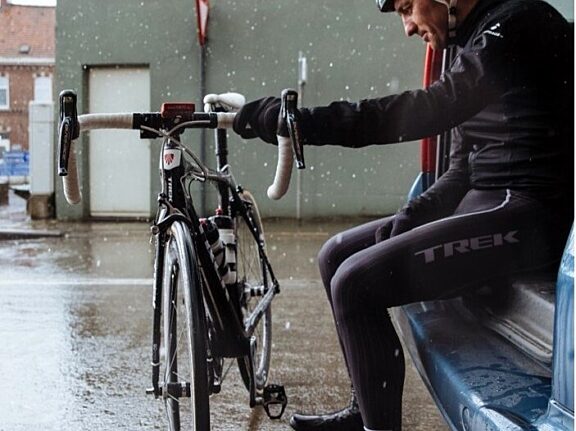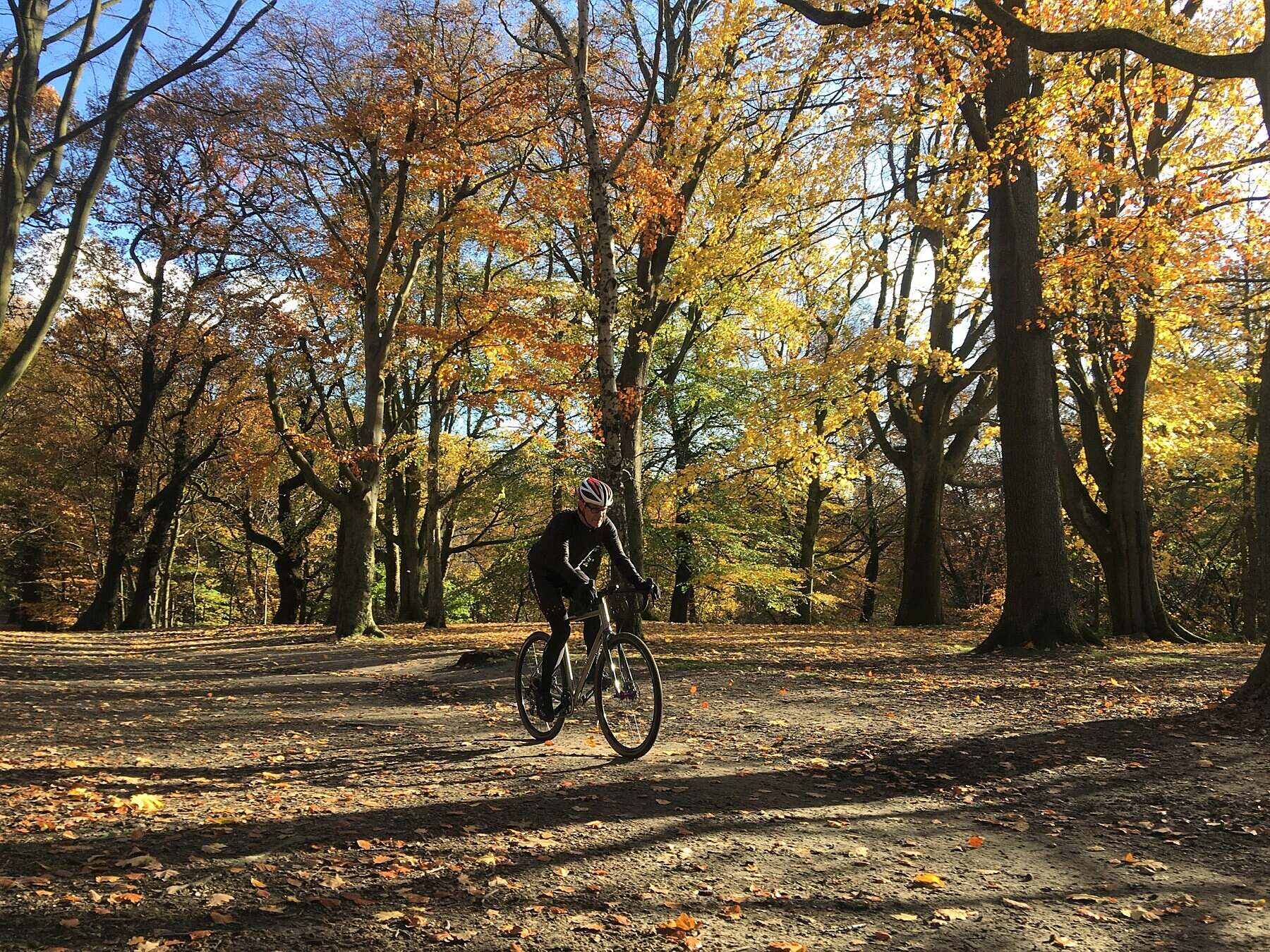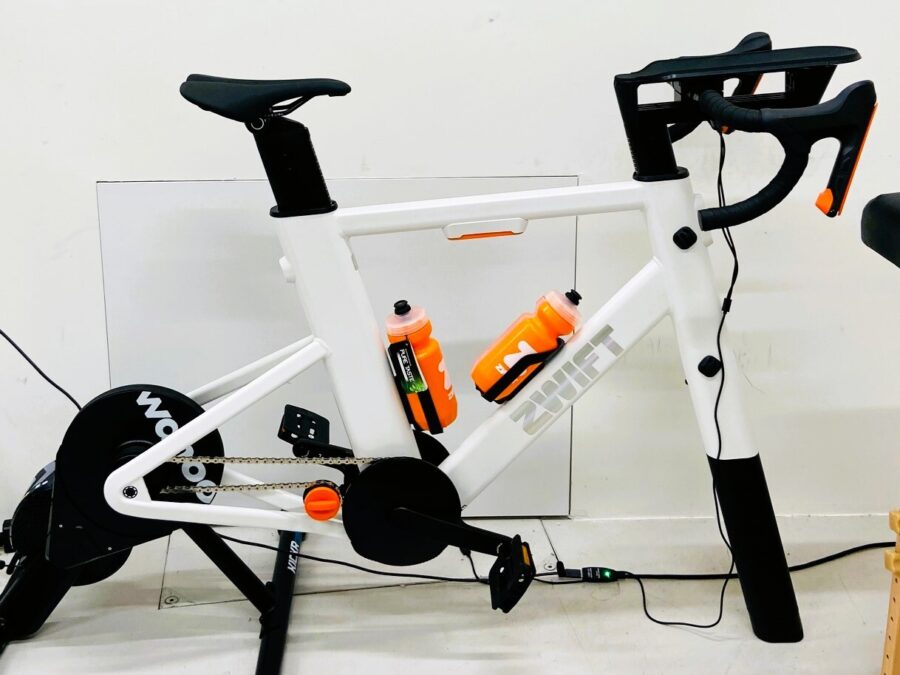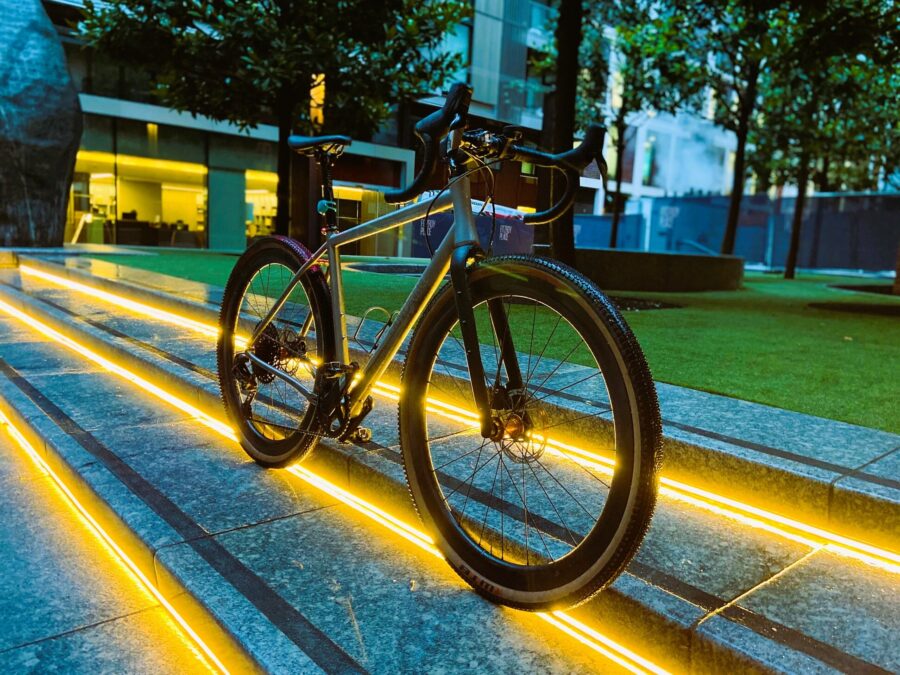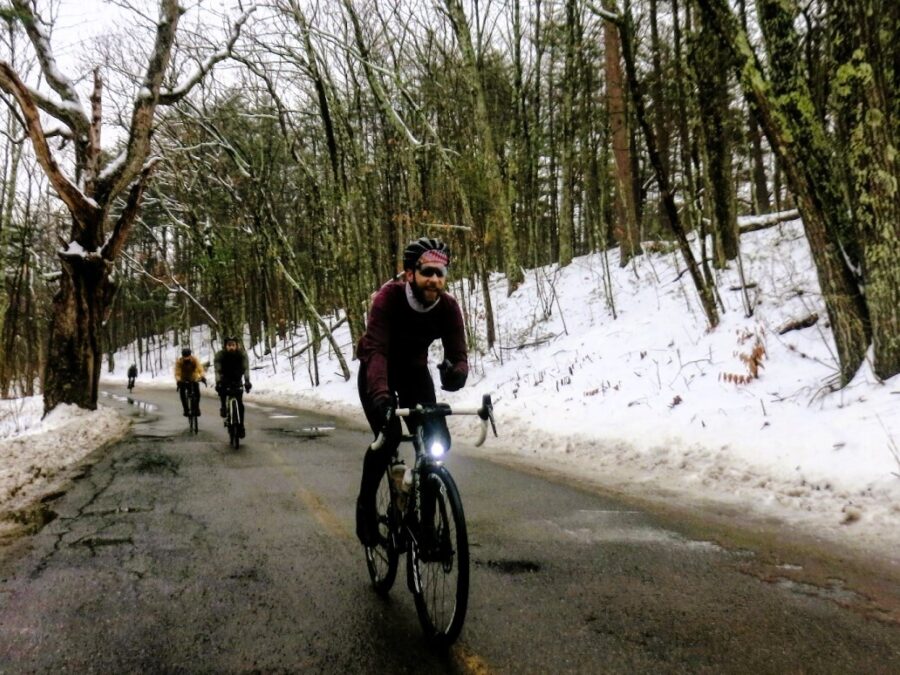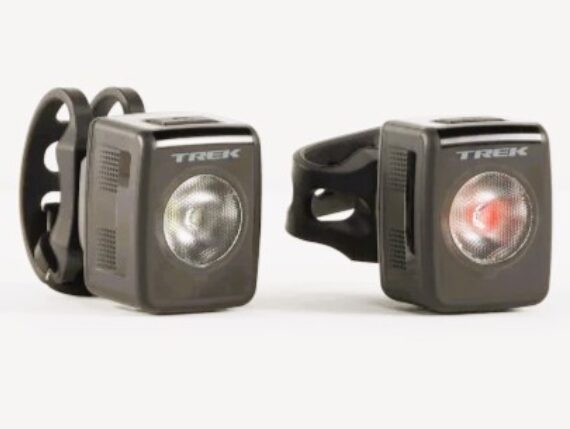Seasonal Shrinkflation
We do love the whole winter-riding essay genre. Made all the more important because 2024 was officially the first year that we went from the traditional four seasons, down to two.
Lost Forever
Lost forever, are of course spring and autumn. Replaced on the new timetable by an elongated winter and a severely truncated summer.
Even if you did happen to miss the memo, it should all still be abundantly clear by now.
Navigating The New Winter/Summer Paradigm
Okay, so in the new riding universe, we need to squeeze the lemons of summer sunshine riding until their little pips squeak, and at the same time assiduously prepare for the challenges of winter riding, to turn that chilly frown upside down. Here is what we think you need to know about: bikes, components, clothing, riding-technique and finally, maintenance. It is a lot to take in.
"Lost forever, are of course spring and autumn"
Winterise Your Life
Let's set some house rules - because collating and organising Team Cyclefit's views, has exposed hitherto uncharted divisions.
- House Rule Number One - we are not professional cyclists. We ride because we want to, not because we have to. And UK winters are different to Girona winters - see below
- House Rule Number Two - All of what follows assumes a British or British-adjacent climate.
"Outside in the world or inside on a stationary trainer - it doesn't need to be a hard binary"
"Assiduously prepare for the challenges of winter riding, to turn that chilly frown upside down"
Clocks Going Back (100 years)
Nobody can remember why, or whether it was, ever has been, or still is, a good idea. But we do love an unexamined tradition, so Sunday 27th October at 2:00 am we retard our clocks by an hour. The only thing that would make it more British is if we had to queue to do it. Winter has officially begun.
Inside, Outside, Leave Me Alone...
The first winter riding conundrum is whether you plan to train outside in the world or inside on a stationary trainer - this one also divides us at Cyclefit.
But, it doesn't need to be a hard binary, even though there does appear to be increasing polarity. Maybe because indoor set-ups are increasingly sophisticated and immersive - which makes training in your spare room particularly alluring once jet-stream emigrates south of Dijon.
Here are our observations to further fuel the indoor/outdoor debate:
Indoors - For
- Safe & controlled environment - less potential for crashes/injuries
- Superb for structured sessions - easier to micro control training loads and efforts
- Fits into busy lives - make that hour (almost) count!
- Less faff - "where are my bloody overshoes?"
- Arguably less on maintenance - tyres, tubes, etc
- The big-one - No Bike Cleaning!
Indoors - Against
- Training indoors can stress the body in a different way - saddle, upper body, knees, hips etc.
- We can sometimes ride differently - maintaining power in the abstract world can lead us to adapt our pedalling: cadence, body-position, gearing, over-use of up-stroke etc.
- Understandable temptation to exchange intensity for duration.
- Doesn't help with the craft of riding a bike in mixed conditions. We see this at team level when new athletes have made themselves into supercharged watt-boxes, but can't ride a race-bike with sufficient skill and confidence to be useful. Choose to be more like Tom Pidcock, who has ridden his bike outside a lot over the years!
- Being outdoors has been proven to help with our mood and mental health in the winter.
An Unusual Outbreak of Common Sense
Mixing riding outside with a capability to train indoors if required, is the ideal scenario. Work out your own perfect indoor/outdoor algorithm. Maybe use the stationary trainer to extract the greatest training effect from your hardest sessions. And as a fall back for the days when you are sick of rain, cold, wind, or all three.
Maybe also plan to use the road to deepen your fitness. Riding outside is satisfying, fun and most importantly, stochastic. The wide-world is more chaotic, which is often good because it forces us to vary intensity, position, cadence etc.
Training hygiene
Not many of us would head out on the road to do some hill repeats at 10pm after getting home late from work. But plenty of us do precisely that if we have an indoor set-up ready to go. A pain-cave is fine in principle as long as we use it intelligently.
No such thing as junk miles
Most of us at Cyclefit think that it is a privilege to be able to build everyday riding into your commute. There is no such thing as junk miles, just junk thinking. Commuting is a brilliant way to loosen up your mind and body on your way to work, and decompress you on your way home. Mixing up routes helps with left-handed thinking and breaks our human fixation with routine. These are all free miles and an expeditious use of time. In an unofficial poll, our clients who commute by bike are 67.4% happier than those who commute by car.
But...
Leave the bike at home if the temperature goes anywhere near zero or the conditions become borderline survivalist - we see the results of this every freeze, when it goes wrong - time off the bike, expensive repairs and worst of all, back on the train/bus/tube ....agggh.
You will always find a cup of coffee and a truly sympathetic ear at Cyclefit if this happens to you. But it won't get you back on your bike any faster. These are the days that indoor cycling makes complete sense.
"Choose to be more like Tom Pidcock"
Winter Kit 101
There is one thing we can all agree on and that is riding through the thick of winter with substandard kit is just awful. What follows is the products or our joint experience. We only recommend what we use. And we only use what works.
The Bike
A winter-bike serves a very different purpose to your race/event/best-day bike. There is no obvious requirement for it to be the lightest, stiffest, most aero, cutting-edge sharpened scalpel (although some folk just prefer that kind of a ride all year round). Beyond everything a winter-bike's role is to beckon you off the sofa like a friendly, loyal hound, and then look after you out in the field. It is a bike that you should look forward to riding because it is so: comfortable, predictable in all conditions and forgiving of unseen potholes, missed apexes, deep puddles and cold hands. For all of us (regardless of age or aspiration) the perfect winter bike is characterised by:
- Clearances and secure fixing for full mudguards.
- Lower bottom-bracket to reduce overall centre-of-gravity - sit a little deeper in the bike.
- More forgiving geometry - we will be wearing more restrictive clothing in the winter and maybe riding with cold muscles and a touch more weight. Don't hesitate to slightly shorten the reach and increase the stack in the winter.
- Disc-brakes (do we still need to advocate for this?)
- Go up a tyre size or even two - 30 - 32mm seemed to be the consensus at Cyclefit.
- Electronic gears are more reliable in the winter - counter-intuitive but true - no cables to rust or stick.
- Carbon is fine for the winter, but you may not want the stiffest, highest modulus carbon. Lower modulus will be more comfortable and less reactive to bad road surfaces and big bumps.
- Titanium and steel are also excellent. Especially titanium because it can't rust, has legendary strength and comfort. Maybe the best winter material in our opinion.
"There is no such thing as junk miles"
Winter Kit - Cyclefit Team Tips
Winter Tyres
The major schism in Cyclefit is still tubeless versus non-tubeless. When we wrote Barna's Workshop Tips in February of this year, it was only Barna and Phil holding out with clinchers.
Phil bobs back and to with tubeless, according to who he spoke to last, so this technically leaves Barna is out in the cold all on his own on clinchers. But as Workshop Manager, it would be hasty to dismiss his opinion. Barna uses Conti 4Seasons and the rest of the team are on Conti GP5000AS (All Seasons). Jimmy Wilson got 8000km from one set of 28mm GP5000AS's with only four punctures!
Dynaplug Team Unity
All of the team are united that should the worst happen and your tubeless tyre doesn't self-seal, that Dynaplug are the best darts to have in your seatpack.
Jimmy adds a bit more detail based on his own experience:
"I use a pump rather than a cannister, when I have to plug a hole as a cannister can breach the seal and blow the dart. I use the pump to gently take the pressure to 40psi to get me home - I would then patch the inside of the tyre to effect a more permanent repair"
Barna is now coaxed into the 'managing a tubeless road-side crisis' conversation:
"If you have a hole that isn't sealing, I still wouldn't bother putting a tube in - it will be really messy. If the Dynaplug doesn't work, then you have done your best and it's time to call a taxi."
This may serve to explain Barna's mild bias against tubeless. He rides huge mileages, punctures very occasionally but can repair anything blindfold in significantly less than 90 seconds. Most of us are not Barna.
Barna's Workshop Tips - Tubeless v's Clinchers
The Mudguard Ratchet & Cycling's Flat-Earthers
There was unanimity when it came to mudguards. There were no dissenters. And consensus reached:
- Mudguards should be securely fixed with eyelets
- They should definitely not rattle
- Mudflaps protect your feet and the eyes of the rider behind you
- Carbon-fibre are best (Jimmy's inclusion)
- SKS are reasonably priced and do the job. Pop them on in October and take them off at the end of March - timings may have changed with the new 2-season model.
- Mudguards will change your life. They will be an epiphany. They are a ratchet and you will never go back
Anything else?
- Ride with lights - even during the day. Barna's favourite are Trek's Trek Ion 200 RT set £89.99 (pictured). He handles all our warranty claims, so his judgement will be sound
- Re-calibrate for the dark - Jimmy's tip is that riding in the dark can catch you out - it takes time to re-calibrate - riding in the dark is a skill that needs to be learnt or at the very least, re-learnt
- Squirt Chain-lube - the advice has changed. No longer do we recommend winter-lube. Use Squirt all year round!
Interesting Links
Barna's Workshop Tips - Part I (Tyres, Tubeless, Sealant, Plugs)
Barna's Workshop Tips Part II (Chains, Lubes, Maintenance)

